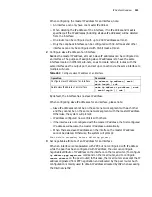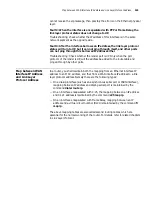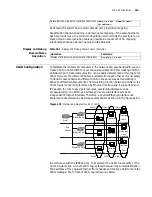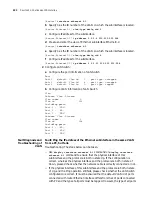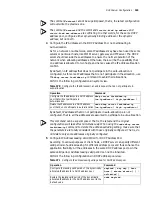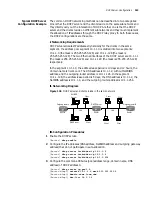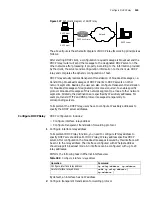
DHCP Server Configuration
333
connected with PC must be set as “untagged” for the reason that PC cannot
identify data packet marked with VLAN tag.
Fault: Ping Two PCs, but fails to ping them through.
Troubleshooting: The steps below can be taken.
■
First, ping the IP address of Ethernet subinterface in the same VLAN from a PC.
If the ping fails, solve the problem according to the method described in fault
one.
■
If one PC can ping through the IP address of Ethernet subinterface in the same
VLAN, but fails to ping through another PC, please use the command
route
in MS-DOS of the two PCs to see if the route to peer PC is available. If
not, please add the relevant route.
DHCP Server
Configuration
Background of the DHCP development
As the scale of networks grows and their complexities increase, network
configurations become more and more complex. The original BOOTP protocol for
static host configuration cannot satisfy the demands of users, especially on the
occasions when computers are always on the move (e.g., using laptops or wireless
network) and the number of actual computers exceeds that of the available IP
addresses. To facilitate users to improve utilization ratio of resources and to
support diskless networking mechanisms, the DHCP (Dynamic Host Configuration
Protocol) based on BOOTP was developed. Similar to the BOOTP protocol, DHCP
works in client-server mode. With this protocol, a DHCP client can dynamically
request configuration information from a DHCP server, including important
parameters such as assigned IP addresses, subnet masks and default gateways,
etc. DHCP server can also conveniently configure this information dynamically for
DHCP clients.
DHCP vs BOOTP
■
Both BOOTP and DHCP adopt the client/server communication mode. A client
applies to the server for configurations (including the configurations of
important parameters such as allocated IP address, subnetmask, and the
default gateway). Then, the server will return the corresponding configuration
information according to the policies. Both types of packets are encapsulated
with the UDP packets. Furthermore, their structures are almost the same.
■
BOOTP is running in a relatively static (every host is connected by a permanent
network) environment. Hence, administrators should configure special BOOTP
parameter files for each host and then, these files will stay the same for a
relatively long time.
■
DHCP extends the BOOTP from two aspects: DHCP enables computers to
obtain all the needed configuration information by using one message and it
allows computers to rapidly and dynamically obtain IP addresses so to avoid
statically specifying addresses for each host by BOOTP.
IP address allocation policy provided by DHCP
Different hosts have different application requirements. For example, some
servers perhaps need to use the fixed IP addresses for a long time, some hosts
need to use certain IP addresses dynamically allocated for a long period of time
and some individuals can arbitrarily use the allocated temporary IP addresses. A
Summary of Contents for 3036
Page 1: ...http www 3com com 3Com Router Configuration Guide Published March 2004 Part No 10014299 ...
Page 4: ...VPN 615 RELIABILITY 665 QOS 681 DIAL UP 721 ...
Page 6: ...2 ABOUT THIS GUIDE ...
Page 7: ...I GETTING STARTED Chapter 1 3Com Router Introduction Chapter 2 3Com Router User Interface ...
Page 8: ...4 ...
Page 16: ...12 CHAPTER 1 3COM ROUTER INTRODUCTION ...
Page 34: ...30 ...
Page 60: ...56 CHAPTER 3 SYSTEM MANAGEMENT ...
Page 98: ...94 CHAPTER 6 DISPLAY AND DEBUGGING TOOLS ...
Page 110: ...106 ...
Page 114: ...110 CHAPTER 8 INTERFACE CONFIGURATION OVERVIEW ...
Page 158: ...154 CHAPTER 10 CONFIGURING WAN INTERFACE ...
Page 168: ...164 ...
Page 188: ...184 CHAPTER 13 CONFIGURING PPPOE CLIENT ...
Page 192: ...188 CHAPTER 14 CONFIGURING SLIP Router ip route static 0 0 0 0 0 0 0 0 10 110 0 1 ...
Page 248: ...244 CHAPTER 16 CONFIGURING LAPB AND X 25 ...
Page 320: ...316 ...
Page 330: ...326 CHAPTER 20 CONFIGURING IP ADDRESS ...
Page 362: ...358 CHAPTER 21 CONFIGURING IP APPLICATION ...
Page 374: ...370 CHAPTER 23 CONFIGURING IP COUNT ...
Page 406: ...402 CHAPTER 25 CONFIGURING DLSW ...
Page 408: ...404 ...
Page 452: ...448 CHAPTER 29 CONFIGURING OSPF ...
Page 482: ...478 CHAPTER 30 CONFIGURING BGP ...
Page 494: ...490 CHAPTER 31 CONFIGURING IP ROUTING POLICY ...
Page 502: ...498 ...
Page 508: ...504 CHAPTER 33 IP MULTICAST ...
Page 514: ...510 CHAPTER 34 CONFIGURING IGMP ...
Page 526: ...522 CHAPTER 36 CONFIGURING PIM SM ...
Page 528: ...524 ...
Page 532: ...528 CHAPTER 37 CONFIGURING TERMINAL ACCESS SECURITY ...
Page 550: ...546 CHAPTER 38 CONFIGURING AAA AND RADIUS PROTOCOL ...
Page 590: ...586 CHAPTER 40 CONFIGURING IPSEC ...
Page 599: ...IX VPN Chapter 42 Configuring VPN Chapter 43 Configuring L2TP Chapter 44 Configuring GRE ...
Page 600: ...596 ...
Page 638: ...634 CHAPTER 43 CONFIGURING L2TP ...
Page 649: ...X RELIABILITY Chapter 45 Configuring a Standby Center Chapter 46 Configuring VRRP ...
Page 650: ...646 ...
Page 666: ...662 ...
Page 670: ...666 CHAPTER 47 QOS OVERVIEW ...
Page 700: ...696 CHAPTER 49 CONGESTION MANAGEMENT ...
Page 706: ...702 CHAPTER 50 CONGESTION AVOIDANCE ...
Page 707: ...XII DIAL UP Chapter 51 Configuring DCC Chapter 52 Configuring Modem ...
Page 708: ...704 ...
Page 762: ...758 CHAPTER 52 CONFIGURING MODEM ...



